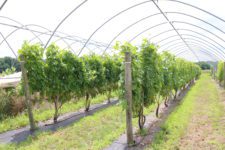Oct 24, 2022High tunnel grapes thrive in tough locations
Researchers are pursuing a project initiated during a 2018 Michigan State Ag Innovations Day to evaluate the potential for high tunnel warm-season winegrape cultivar plantings.
The goal is to confirm that winegrape quality and yield are improved significantly and would allow for successful production in regions that have less-than-ideal growing environments.
A July 27 presentation at the 2022 Viticulture Field Day at MSU’s Southwest Michigan Research and Extension Center (SWMREC) in Benton Harbor, Michigan, was given by tree fruit specialist Greg Lang.


The tunnels are 24- by 200-feet each. Tunnels 5 and 7 were planted in spring 2018 to 12 vines each of Malbec, Merlot, Syrah and Teroldego, and 24 vines of Cabernet Sauvignon. Tunnel 5 is covered from late spring through early fall; Tunnel 7 has always been open. Vine spacing is 7.5 by eight feet (about 725 vines per acre).
“At the end of the first year, it was night-and-day difference,” Lang said of the tunneled and non-tunneled comparison. “It was so much better the way the fruit and the vines grow under the tunnel, the same way we’ve seen everything else we’ve ever grown in tunnels. What we’d also like to do in the future is figure out what light transmission properties would optimize our photosynthesis and our phenolic development and everything.
“The interesting thing coming out of that winter of 2019 is we had a lot of winter kill in the Malbec and Syrah,” he said. “We only had one vine survive out of 12 in each of those two varieties outside. The tunnel is uncovered in the winter so the vines were exposed to the same winter conditions but they were just so much healthier going into the winter, with more carbohydrate reserves, that sort of thing. They came through really well. We lost just one or two (vines).”
Both inside and outside, the Merlots survived 100%. Of the five trialed varieties, Merlot seems to be the most cold-hardy. Cabernet is second-best.
“We’ve got about 80-90% of those still alive and those we lost came from the virus they apparently came from the nursery with,” Lang said.
Malbec had less than 10% alive outside the tunnel, but inside, 83% were still alive.
The Syrah had only less than 10% survive outside the tunnel, all due to winter injury that first year.
“Inside the tunnel, two-thirds of them are alive,” Lang said. “The ones we lost were a little bit due to winter, but also due to the virus.”
With the Teroldego, which comes from northern Italy, and should be cold-hardy, “apparently all of those vines came with crown gall, and that’s been killing them ever since. We only have about 50% of those alive inside and outside.”
Researchers harvested for the first time in 2020 from inside the tunnel.
“The vines were so weak outside they weren’t big enough to have any harvest,” Lang said. “In 2021, we harvested inside and outside. So being the second harvest inside last year, it was the first harvest outside, and much smaller.”
Only inside grapes were harvested in 2020. The Cabernet yielded about 3.7 tons per acre.
“It was a very good yield on the third leaf,” he said.
Researchers are interested in yields, brix and titratable acidities for wine quality.
“That year (2020), we had about 22 degrees brix, a little bit low compared to out West, but I was pleased we had achieved that,” Lang said. “The acidity was quite high that year. That was for the Cab.
The Cabernet grapes fully ripened in the tunnel that year. Lang said conventional wisdom is that long-season grapes for hardy red wines aren’t a fit for Michigan weather over the winter, but with the tunnel, it appears the necessary heat units can be attained.
In 2021, for the fourth year outside, one ton per acre was harvested.
Inside the tunnels, vines produced 6-7 tons per acre, with two different harvests on the north end and south end (of the vineyard), about two weeks apart. Those 6-7 tons are high yields for Cabernet, and brix were about the same again, about 21 degrees.
“One of the questions going into this year is, if we thin the crop load on some of the vines, can we get those sugars up to 34-25 brix?” Lang said.
The 2020 Merlot crop again had 3-4 tons per acre, similar to the Cabernet, with 23 degrees brix. Last year, the unprotected Merlot produced less than a ton per acre, compared to eight tons per acre under the tunnel. Brix dropped because of the high production, at around 22 brix.
“Last year, our acidity across the board was much lower,” Lang said. “I’m thinking maybe because of warmer nights, at those higher temperatures we were losing some of those acids, perhaps.”
The Syrah in the tunnel in 2020 produced two tons per acre. Last year it was eight tons per acre, with Brix around 20-21.
The Malbec crop was almost 4 tons per acre for the first yield, six tons per acre last year.
“Brix were 22-23, so we’re really close to what we would probably like to target.”
The Teroldego had two tons per acre for the first harvest, and “very good brix at 26, with good acidity,” Lang said.
“This past year (the Teroldego) suffered spring frost damage,” he said. “The primary flower buds were damaged so we cropped on secondary buds. The yield actually fell the second year from 2 tons down to 1.5 tons last year. They were the only variety in which we saw that spring damage. In the Teroldego you get really good brix, so they do tend to ripen earlier.”
— Gary Pullano, senior correspondent
Photo: An evaluation that seeks to confirm that winegrape quality and yield are improved significantly and would allow for successful production in regions that have less-than-ideal growing environments. PHOTO: Gary Pullano














